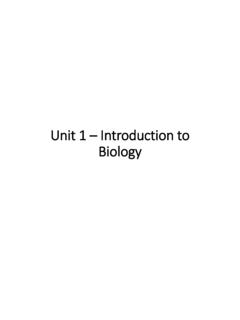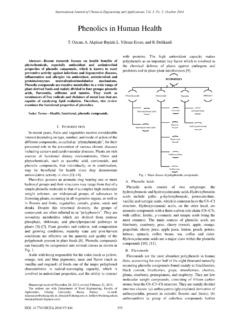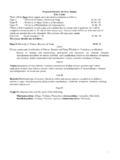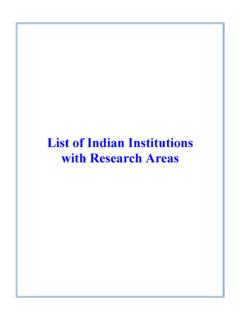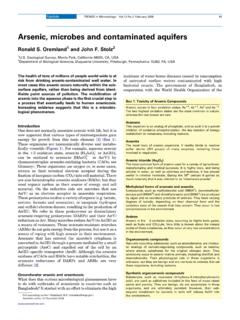Transcription of Veterinary Mycology - Encyclopedia of Life Support Systems
1 UNESCO EOLSSSAMPLE CHAPTERSVETERINARY SCIENCE - Veterinary Mycology - Jalpa P. Tewari Encyclopedia of life Support Systems (EOLSS) Veterinary Mycology Jalpa P. Tewari Department of Agricultural, Food, and Nutritional Science, University of Alberta, Canada Keywords: Anamorph, animal mycoses, animal pathogenic fungi, Ascomycota, aspergillosis, Basidiomycota, blastomycosis, candidiasis, chytridiomycosis, Chytridiomycota, coccidioidomycosis, cryptococcosis, dermatophytosis, emerging fungal diseases, Eumycota, histoplasmosis, Malassezia dermatitis and otis externa, mycotoxicosis, paracoccidioidomycosis, penicilliosis, sporotrichosis, teleomorph, zoonosis, zygomycosis, Zygomycota. Contents 1. Introduction 2. Characteristics and Classification of Fungi 3.
2 Dermatophytosis 4. Malassezia Dermatitis and Otis Externa 5. Blastomycosis 6. Histoplasmosis 7. Cryptococcosis 8. Coccidioidomycosis 9. Paracoccidioidomycosis 10. Sporotrichosis 11. Aspergillosis 12. Penicilliosis 13. Candidiasis 14. Zygomycosis 15. Mycotoxicosis 16. Conclusions Acknowledgments Glossary Bibliography Biographical sketch Summary Animals are hosts to numerous fungal pathogens most of which can also infect humans. In some cases, these diseases can be transmitted from animals to humans or vice versa. Many wild, agricultural, and domestic animals constitute reservoirs of human fungal pathogens. There has been synergy in technological developments between the human and animal Systems . Understanding of animal diseases has benefited from basic scientific and therapeutic understanding of human diseases whereas understanding of human diseases has benefited from use of animal models for various experimentations.
3 Animals harbor some discrete ecological groups of fungi. Most of them are widely distributed environmental facultative parasites. In contrast to these fungi, Malassezia UNESCO EOLSSSAMPLE CHAPTERSVETERINARY SCIENCE - Veterinary Mycology - Jalpa P. Tewari Encyclopedia of life Support Systems (EOLSS) spp., Piedraia spp., and Pneumocystis jiroveci are obligate pathogens. Some facultative parasites are endemic in limited areas. These fungi include some of the more virulent fungal pathogens and can infect immune-compromised and even immune-competent subjects. Most widely distributed environmental fungi are opportunistic pathogens on debilitated or immune-suppressed subjects. Many fungi produce readily dispersed conidia which can initiate infection.
4 For pulmonary infection, the conidia have to be small-enough to be carried by air currents and deposited deep in the alveoli. A small number of fungi are commensal on the skin surface and some undergo morphogenetic switching in order to initiate infection. Thermally induced dimorphic transition from the saprobic mold to pathogenic yeast phase is important for pathogenicity and virulence in some fungi. Fungal pathogens of animals range from a unicellular chytrid to numerous unicellular yeast and multicellular filamentous types. They belong to many fungal taxa and exhibit a diversity of morphologies, and asexual and sexual reproduction types. A range of technologies have been developed for diagnosing fungal infections. They generally include symptomatic observations at the Veterinary clinic, culturing of the pathogen, cytologic and histological evaluations, and serologic and DNA-based testing.
5 1. Introduction Fungi serve essential roles in the global ecosystem. Their activities degrade organic matter, recycle nutrients, create soils, and promote plant growth. Without their saprobic activities, humans will drown in a deep layer of leaf litter. They parasitize humans, animals, and plants, and regulate biodiversity. They serve as food for humans and animals, and produce fermentation products for humans. Fungi have versatile biochemistry and produce myriads of chemical compounds. Many of these biochemicals are used by humans as medicines and other industrial chemicals. Fungal diseases affect the health and consequently the survival of wild and domesticated animals. In this respect there is a close relationship between humans and animals since they suffer from many of the same fungal pathogens.
6 The zoonotic diseases are able to be transmitted from wild, agricultural, and domestic animals to humans either directly or through vectors. The opposite transmission is called reverse zoonosis. Sporotrichosis caused by Sporothrix schenckii and ringworm caused by Microsporum spp. and Trichophyton spp. are well-known examples of zoonoses. Many wild and domesticated animals (including their feces and soil in their burrows) harbor reservoirs of fungi pathogenic on humans. Some examples of such fungi are Blastomyces dermatitidis, Candida spp., Coccidioides immitis, Cryptococcus neoformans, Histolplasma capsulatum, Malassezia spp., and Paracoccidioides brasiliensis. Close relationships exist among different components in some disease syndromes.
7 For example, in South America, outbreaks of coccidioidomycosis have taken place in armadillo hunters and in hunters dogs. The causal agent C. immitis has also been isolated from armadillos and from its burrow soil. Several factors are contributing to evolution of emerging zoonotic diseases. Pre-existing diseases are being dispersed through rapid global transportation of animals and humans. Animal trade is also contributing to dispersal of diseases. Contacts between humans and animals are increasing. Numbers of immune-suppressed subjects predisposed to fungal infection are UNESCO EOLSSSAMPLE CHAPTERSVETERINARY SCIENCE - Veterinary Mycology - Jalpa P. Tewari Encyclopedia of life Support Systems (EOLSS) also increasing. Additionally, more and more fungal diseases are being recognized through recent advances in diagnostic technologies.
8 Some novel diseases have been recognized in wild animals in the recent past. These emerging infectious diseases include the frog chytridiomycosis, coral fungus, and crayfish plague caused by Batrachochytrium dendrobatidis, Aspergillus sydowii, and Aphanomyces astaci, respectively. Fusarium sp. is also emerging as an important pathogen of captive marine fish, especially elasmobranchs. Out of the above mentioned fungi, A. astaci is not regarded as a fungus as it is now placed under Ooomycetes. At least one of these pathogens has significantly affected animal biodiversity. Batrachochytrium dendrobatidis was first described in 1998 and causes chytridiomycosis in more than 90 species of amphibians worldwide.
9 While the principal drivers of this phenomenon remain unclear, this chytrid has caused decline and extinction of numerous amphibians underscoring the ecological significance of animal mycoses. It is strongly believed that international trade is contributing to introduction of this pathogen in new areas. Batrachochytrium dendrobatidis is an aquatic fungus that infects the keratinized stratum corneum of adult amphibians producing sporangia with zoospores in them (Figure 1). The infection causes hyperkeratosis and sloughing of the epidermis. Figure 1. Section of the ventral skin of upper hind limb of Atelopus varius showing sporangia of Batrachochytrium sp. with zoospores. Arrowheads point to discharge tubes with exiting zoospores [A Centers for Disease Control and Prevention image in Public Domain copied from Daszak P.]
10 Et al. (1991)]. Fungi causing diseases in animals are broadly classified into two groups. Endemic fungi are restricted geographically and can potentially cause serious infections in immune-competent animals. These pathogens are highly virulent and are called true or primary pathogens. Immune-competent animals exposed to such fungi generally fight-off infection easily and are asymptomatic. However, if exposed to a large enough inoculum, an animal with an intact immune system may develop chronic infection requiring treatment. An immune-compromised animal upon infection may easily develop life -threatening systemic and progressive malady. For causing deep mycoses, conidia of the mold phase of these pathogens usually gain access into the host via the respiratory tract.










